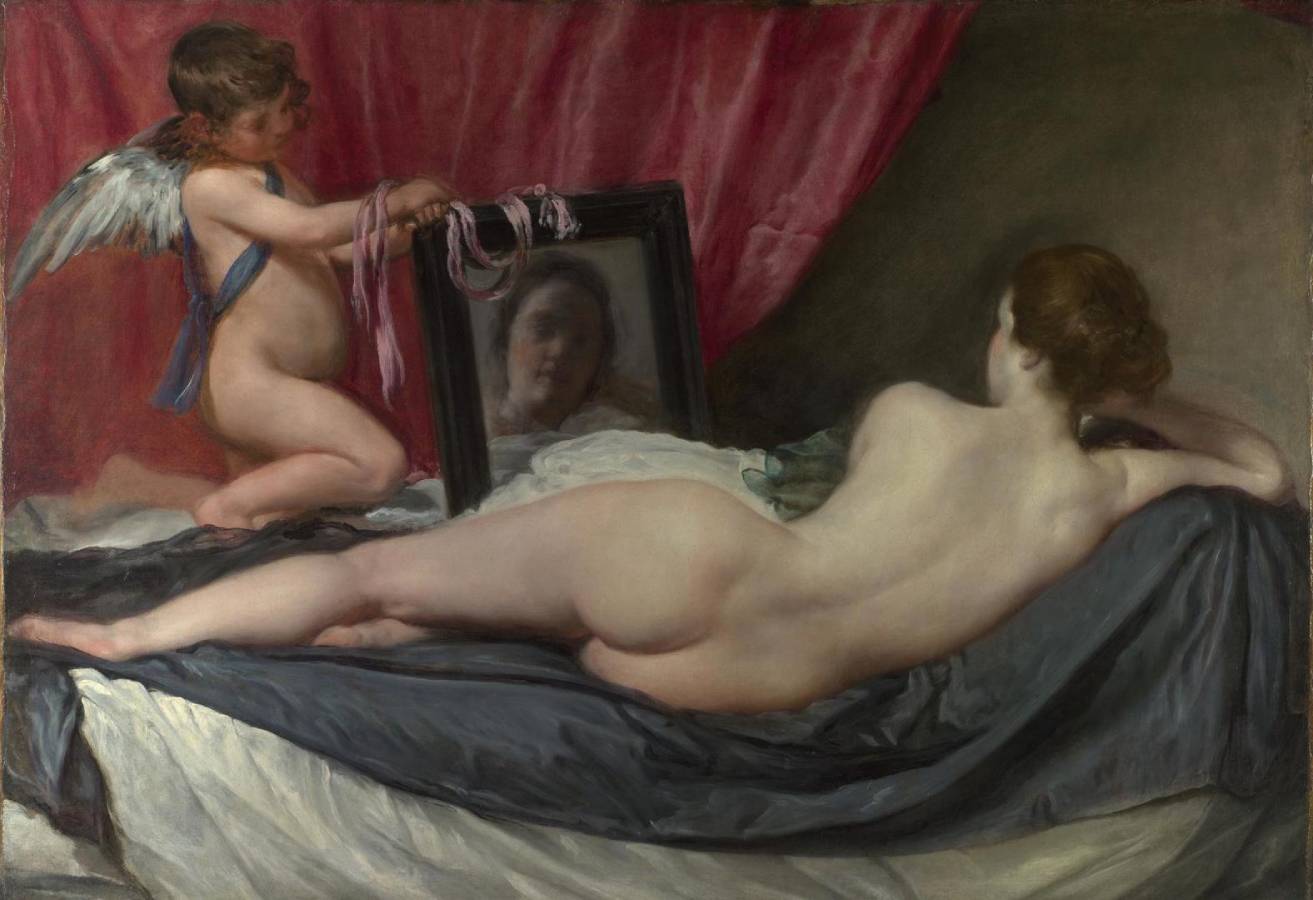Velázquez, Diego (1599-1660)
Venus del Espejo (Venus at her Mirror, The Rokeby Venus)
1647–1651
Oil on canvas, 122.5 x 177 cm
National Gallery, London
This is the only surviving female nude painted by Velázquez. The subject was rare in seventeenth-century Spain, where overtly sensual images were met with disapproval by the Catholic Church. In spite of this the king, and wealthy Spanish art collectors in his circle, did own mythological paintings depicting nudes by artists such as Rubens and Titian.
Venus, the goddess of love, reclines languidly on her bed, the curve of her body echoed in the sweep of sumptuous satin fabric beneath her, which was originally more purple than grey in tone. Cupid, her son, holds a mirror up to her, its intertwining pink ribbons – used to hang it on a wall – knotted at the top. The way these ribbons cross Cupid’s wrist may allude to a blindfold, one of his attributes, or to the shackles he used to bind the hearts of lovers.
Venus‘ reflection is blurred: we can’t see who she really is. Perhaps Velázquez wanted to make sure that the goddess – the personification of female beauty – was not an identifiable person; we have to ‘complete’ her features with our imagination. Velázquez originally painted Venus‘ head slightly more in profile so that her nose was visible, but he later changed his mind; perhaps he thought that this would give too much away. That we view this woman from behind and cannot see her face clearly in the mirror is part of what makes the image so intriguing.
The glowing, pearly tones Velázquez has used for Venus’ smooth skin contrast with the rich colours and lively brushstrokes of the curtain and sheets. Cupid’s face and far leg are very loosely painted and appear almost unfinished: Velázquez deliberately used a sketchy style in order to focus our attention on Venus.
Paintings of the naked Venus had been made popular by sixteenth-century Venetian painters, especially Giorgione and Titian. Here Velázquez has merged two traditional representations of the goddess – one of Venus ‘at her toilet’, where she is normally shown sitting upright on a bed, looking at herself in a mirror, and another of her reclining, usually in a landscape. The result here is an image of astonishing originality.
We are not sure when and where the painting was made. It has been variously dated to before, during and after Velázquez’s second trip to Italy (1649–51). It does seem to be the painting listed in a household inventory of 1651 of the Spanish painter and art dealer Domingo Guerra Coronel, where it is not said to be by Velázquez and is described simply as ‘a nude woman’ (‘una muger desnuda’). Soon afterwards the painting was purchased by renowned art collector Gaspar de Haro, 7th Marqués del Carpio y de Heliche, in whose collection it was paired with a sixteenth-century Venetian picture of a naked nymph in a landscape, seen from the front. It hung in a large room alongside other mythological paintings and copies of works in the Spanish royal collection, to which Gaspar had privileged access thanks to his close relationship with Philip IV.
In 1687 the painting was inherited by Gaspar’s daughter, Catalina Méndez de Haro, who married Francisco Álvarez de Toledo, 10th Duke of Alba, shortly thereafter. It remained in his family’s prestigious collection until the early nineteenth century when Charles IV of Spain ordered the Duchess of Alba to sell the painting – and other works – to Don Manuel Godoy, his favourite minister. Godoy hung ‘The Rokeby Venus’ alongside Correggio’s Venus and Mercury with Cupid and Goya’s The Nude Maja and The Clothed Maja (both Museo Nacional del Prado, Madrid) in a very private room (described by a contemporary as a ‘gavinete interior’) – it must have been one of the most remarkable cabinets of female nudes in all of Spain.
This painting takes its nickname, ‘The Rokeby Venus’, from Rokeby Park, a country house in County Durham, where it hung for much of the nineteenth century. Since its arrival and public display at the National Gallery in 1906, the painting has become one of Velázquez’s most celebrated works. It continues to inspire both artists and writers, and has been the subject of novels, films, documentaries, artworks and installations. (NG)
